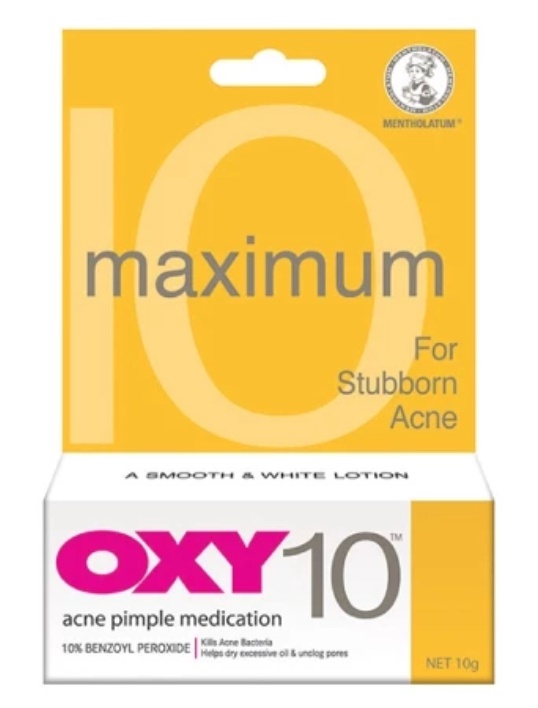
Ingredients overview
Highlights
Key Ingredients
Other Ingredients
Skim through
| Ingredient name | what-it-does | irr., com. | ID-Rating |
|---|---|---|---|
| Benzoyl Peroxide | anti-acne | ||
| Methylparaben (0.15%) | preservative | 0, 0 | |
| Propylparaben (0.05%) | preservative, perfuming | 0, 0 |
OXY Acne Pimple MedicationIngredients explained
The gold standard topical ingredient in treating acne. There is no miracle cure for acne (we do really wish for one, *sigh*), but Benzoyl Peroxide (BP) is probably the closest thing we have. But, as usual, big effects come with big side effects, so we think BP is best used as a last resort (at least, in the topical treatment field).
The good thing about BP is that it is amazingly effective against inflammatory-type acne. Not so much against blackheads or whiteheads, but against acne that is caused by the evil bacteria called Propionibacterium acnes (and that is most types of acne). Apart from being antibacterial, it is also anti-inflammatory, keratolytic and wound-healing, all of which are properties that make it so darn effective against spots.
Another big pro of BP is that there is no bacterial resistance to it, meaning if it works once it will continue to work. Antibiotics are also a common way to treat acne, but antibiotic-resistant P. acnes are increasing worldwide. BP will probably help you even if antibiotics have stopped working, and the two are also often combined for a more complex acne therapy. Btw, BP plays nice not only with antibiotics but also with retinoids.
The side-effects part? BP works its antibacterial magic by being a powerful oxidizing agent, meaning it is a pro-oxidant. As in the opposite of an antioxidant. BP literally generates evil ROS (reactive oxygen species) in the skin that kills P. acnes but also harms the surrounding skin cells. Ongoing BP-use ages your skin, which is why, we say, use it as a last resort. If you do use BP, please also use a good sunscreen and a good antioxidant serum to apologise to your skin (btw, these things are useful in any case). Use the BP treatment at night and the antioxidant serum in the morning so that they do not cancel each other out.
Another side effect of BP is that it can be very skin drying. BP is an example where more is not better. In fact, it is equally effective at concentrations of 2.5, 5.0 and 10%, but the higher the concentration the more irritating and drying side effects occur. So using BP at 2.5% percent is the ideal amount. Another side effect which is good to know is that BP can bleach bedsheets and clothes. Be careful with your expensive satin bedsheets.
Overall, Benzoyl Peroxide is a uniquely effective topical acne treatment, but it comes at a price. Use it as a last resort and for good measure (and with plenty of moisturizers, sunscreen, and antioxidant serum).
The most common type of feared-by-everyone-mostly-without-scientific-reason parabens. It's a cheap, effective and well-tolerated ingredient to make sure the cosmetic formula does not go wrong too soon.
Apart from the general controversy around parabens (we wrote about it more here), there is a 2006 in-vitro (made in the lab not on real people) research about methylparaben (MP) showing that when exposed to sunlight, MP treated skin cells suffered more harm than non-MP treated skin cells. The study was not done with real people on real skin but still - using a good sunscreen next to MP containing products is a good idea. (Well, in fact using a sunscreen is always a good idea. :))
A very common type of feared-by-everyone-mostly-without-scientific-reason parabens. It's a cheap, effective and well-tolerated ingredient to make sure the cosmetic formula does not go wrong too soon.
You may also want to take a look at...
| what‑it‑does | anti-acne |
| what‑it‑does | preservative |
| irritancy, com. | 0, 0 |
| what‑it‑does | preservative | perfuming |
| irritancy, com. | 0, 0 |





